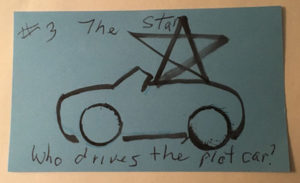Card # 2: the Outcome Card

The Outcome Card asks the question,
“Does (s)he succeed?”
In answering the question on the second card, “Does she or he succeed?” you will figure out if the who gets what she wants or needs. Or more formally, does the protagonist accomplish his goal by the end of the novel?
Let me explain through an analogy. Writing a novel is a trip, and it won’t be a short one like bopping over to the closest QuikTrip to gas up the truck–unless of course the floodwaters are approaching and your protagonist named George must get enough gas not only for the truck but also for the generator back at the house so he doesn’t lose all the frozen food in the freezer during the inevitable power outage. And that way, his family of five including newborn twins . . . Oh, I do so love to write fiction, but let’s press on.
Writing a novel is a long and maybe even an emotionally arduous and physically challenging journey. So it’s good to know where you’re headed when you start out, so you don’t get lost along the way and end up making lots of little side trips that take you nowhere.
To use another analogy entirely . . . Writing a novel is like walking on a tightrope. It really helps if you have the far side of the narrative tethered to something before you start out, if not to a specific rock or tree over there, at least in the general neighborhood of where you want to be at the end.
Besides these reservations, knowing where you’re going lets you know what kind of journey you’ll make and allows you to plan the journey.
We’ll go into those issues later, but now, you should write yes or no on the back of your 3” by 5” card.
Let’s go back to the “girl wants boy” and “boy wants girl” examples we talked about for the heart card.
Yes, of course, Cinderella gets Prince Charming.
I’ve decided to speed things up a little so here’s another card today.

Card # 3: the Star Card
The Star Card asks the question,
“Who drives the plot car?”
On Card # 3, you’ll jot down a few details about who will star in your novel, that is, the kind of person in the leading role. I put the star inside a car because it’s very important that your main character, aka your protagonist, generally drives the plot of your novel and makes its actions happen, especially as he or she nears the end of the journey.
You might not know this character’s name yet, but probably you can already make some basic decisions about this character. Will your protagonist be male or female? How old is your protagonist?
Another thing you might want to explore on your third card–at least a little bit at this point–is why your protagonist wants to accomplish the particular goal that you’ve given that character. To save a life? His own or someone else’s? To prove herself? To clear his name, or her sister’s or his brother’s? To solve the crime and thus keep the murderer from killing more people? Why does Gatsby want Daisy? That question is so easy to answer. The poor guy loves her.
Another thing to think about even at this early stage of brainstorming your novel: what about the star of the novel keeps her from accomplishing her goal and your novel from reaching its outcome right away? He can’t be perfect. None of us are. Besides, perfection is boring. Even Superman has his Kryptonite. Something internal like self-doubt might hold your protagonist back or something external like a broken leg when she’s out in a blizzard.
Tip: avoid putting a complete schmuck in the driver’s seat of your plot car. It makes most readers uncomfortable to be forced to identify with someone capable of the worst villainy without any redeeming virtues at all, an all-powerful being who, for example, wants to wipe every person of color off the planet or destroy the galaxy or remove one person in every two from the galaxy for his own peace and quiet. On the other hand this sort of character will work very well as the . . .
